FLEGER
CODE: P08-RNM-3738
Mapa de flujos de energía en el Estrecho de Gibraltar para su aprovechamiento como fuente de energías renovables
| CHIEF RESEARCHER | Jesús García Lafuente glafuente@ctima.uma.es |
| FUNDING | 138.900 € |
| FUNDER | Junta de Andalucía, Consejería de Innovación Ciencia y Empresa |
| DURATION | 2009 - 2012 |
| Members | |
OBJECTIVES
Within the field of renewable energy, Spain is the fourth in the international ranking of wind power generation after USA, Germany and China and it is rather well situated in solar energy production (both photovoltaic and thermal), an expected fact in a country with a very large amount of sunshine hours. Other sources of renewables are less exploited, as those of oceanic origin: tides, wind waves or marine currents. For the later to be profitable and technically feasible at reasonable cost, marine currents should be intense and as uni-directional as possible. The energy flux of a steady current of 1 ms-1 is about 500 Wm-2 and a three-blade wind-like turbine with 10m long blades working inside the sea water with a realistic efficiency of 0.4 could generate around 60 kW or around 0.52 GWh/year. Such a turbine should keep a fixed orientation for technical and economical reasons, which is a disadvantage with regards to the typical wind-turbines that orientates upwind easily a nd do not demand winds of constant direction. It is not easy to find places in the ocean gathering these requirements of unidirectional and intense marine currents. Large western boundary current systems (Gulf Stream, Kuroshio, Aghullas) are among these places but they flow tens of km away from the shoreline, what implies power loses and high costs to incorporate the energy to the distribution network. Some regions of the Strait of Gibraltar in the southern Spain gather suitable conditions of intense and unidirectional currents that flow quite close to shore. The Strait has been studied since long ago and presently its exchange dynamics is satisfactorily understood. However the sites where the hydraulic control theory predicts unidirectional currents (see Figure) are not fully described and some research is needed to fill this gap and supply the information required by engineers to design submerged farms of wind-like turbines . The project addresses these issues from both an experimental and numerical model approach.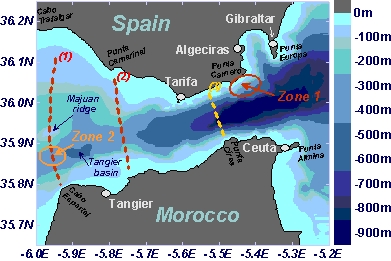
RESULTS
MITgcm model adapted to a Strait of Gibraltar domain of high bathymetry resolution has been used in this work. The model is nested to the CEPOM version of POM developped by the Climatic Modeling Unit of ENEA (G. Sannino and colaborators) GOFIMA collaborates with ( Sannino et al., J. Geophys. Res., 2002, 107, 3094; Sannino et al., J. Geophys. Res. 2004, 109, C05011).
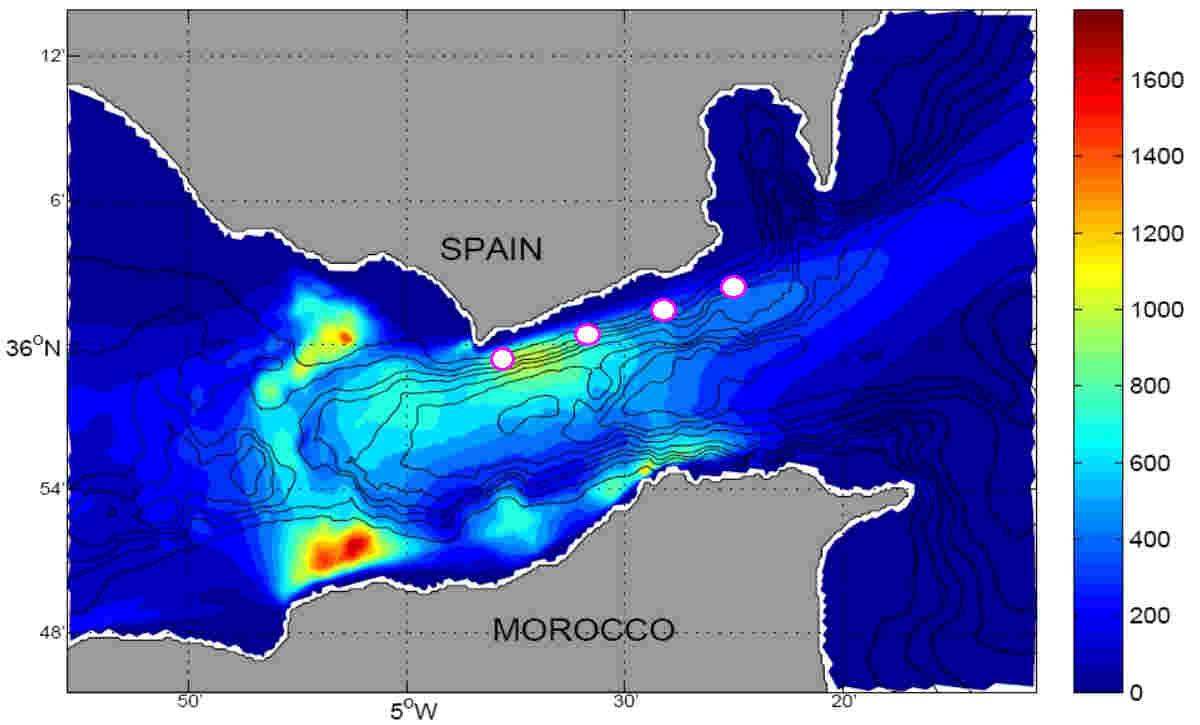 At the same time several mooring lines with an uplooking ADCP have been deployed in the locations indicated in the Figure, which are inside the "zone 1" of the map above. Contour colors correspond to mean modelled energy fluxes in the uppermost layer. Another mooring line located off Cape Espartel in "zone 2", which has been monitoring the outflow since 2004 within INGRES projects, is providing observations that are being also used for the objectives of this study.
At the same time several mooring lines with an uplooking ADCP have been deployed in the locations indicated in the Figure, which are inside the "zone 1" of the map above. Contour colors correspond to mean modelled energy fluxes in the uppermost layer. Another mooring line located off Cape Espartel in "zone 2", which has been monitoring the outflow since 2004 within INGRES projects, is providing observations that are being also used for the objectives of this study.
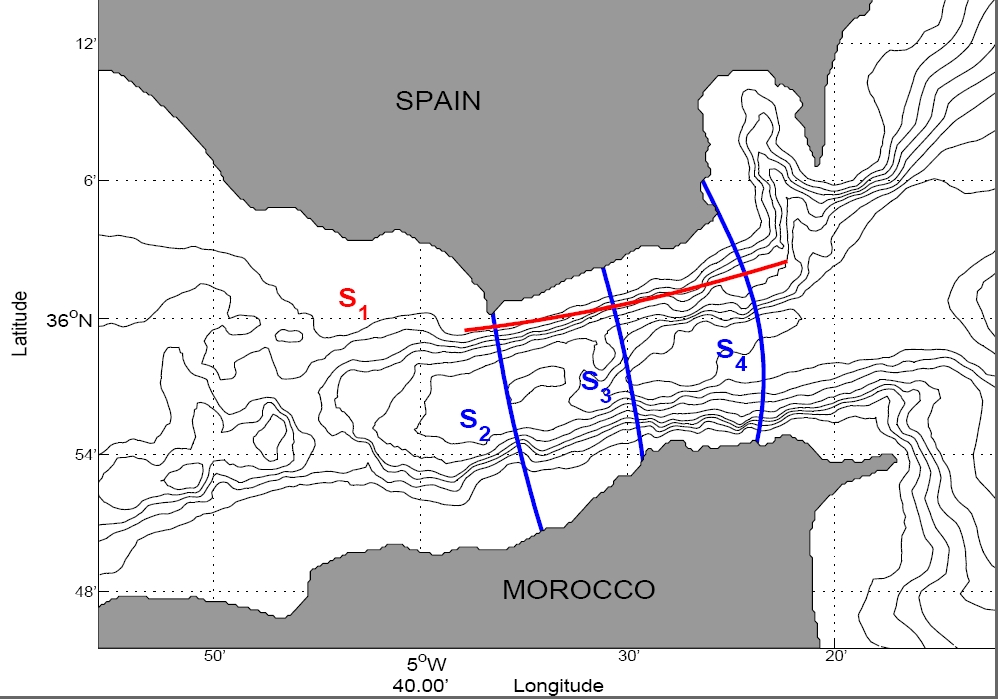
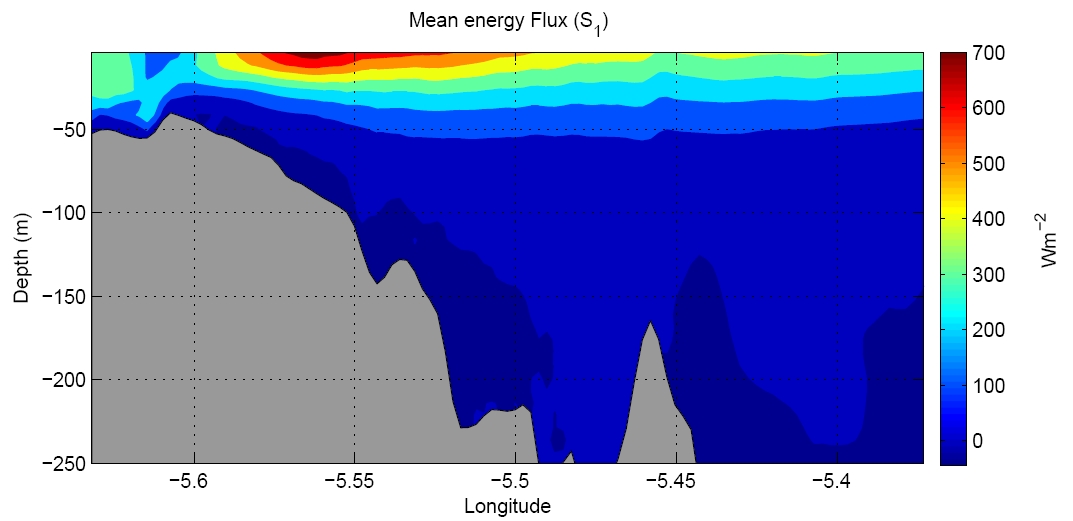
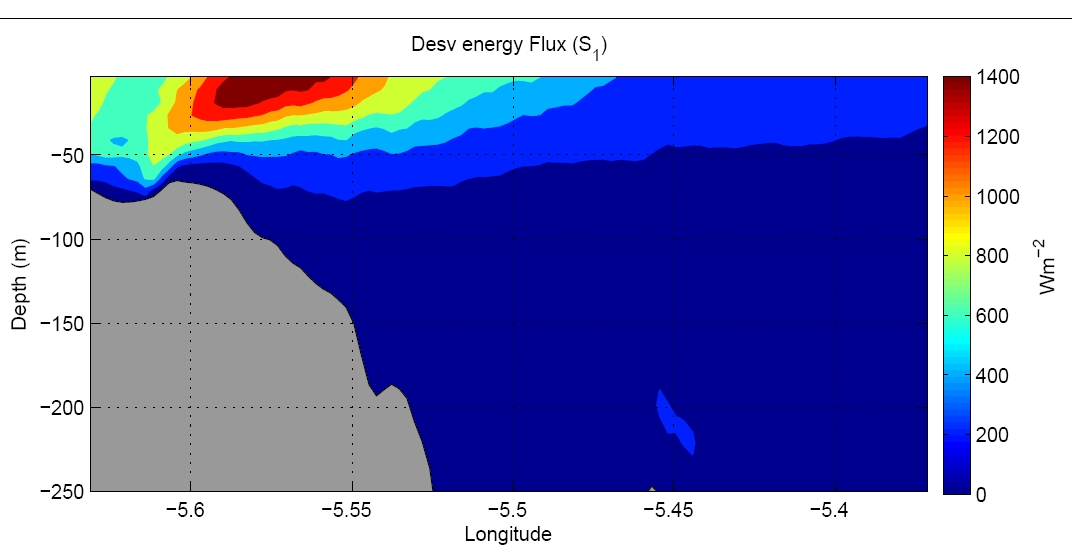 Lower panels show modelled energy fluxes at Section S1 indicated in the map above. Mean values are presented in the left panel (red color is for energy flux of around 700 W/m2 ) while right panel presents th STD which is a proxy of the tidal variability (darkest red indicate values as high as 1400 W/m2 ). It is nearby Tarifa that the modelled values reach its maximum not only for mean but also for STD. Below 60-70 m depth the energy flows drops noticeably as we go into the Mediterranean layer that flows much slower in this art of the Strait. In the eastern half of the Strait surface currents keep the potential for electrical power production. Things are different in the western part.
Lower panels show modelled energy fluxes at Section S1 indicated in the map above. Mean values are presented in the left panel (red color is for energy flux of around 700 W/m2 ) while right panel presents th STD which is a proxy of the tidal variability (darkest red indicate values as high as 1400 W/m2 ). It is nearby Tarifa that the modelled values reach its maximum not only for mean but also for STD. Below 60-70 m depth the energy flows drops noticeably as we go into the Mediterranean layer that flows much slower in this art of the Strait. In the eastern half of the Strait surface currents keep the potential for electrical power production. Things are different in the western part.
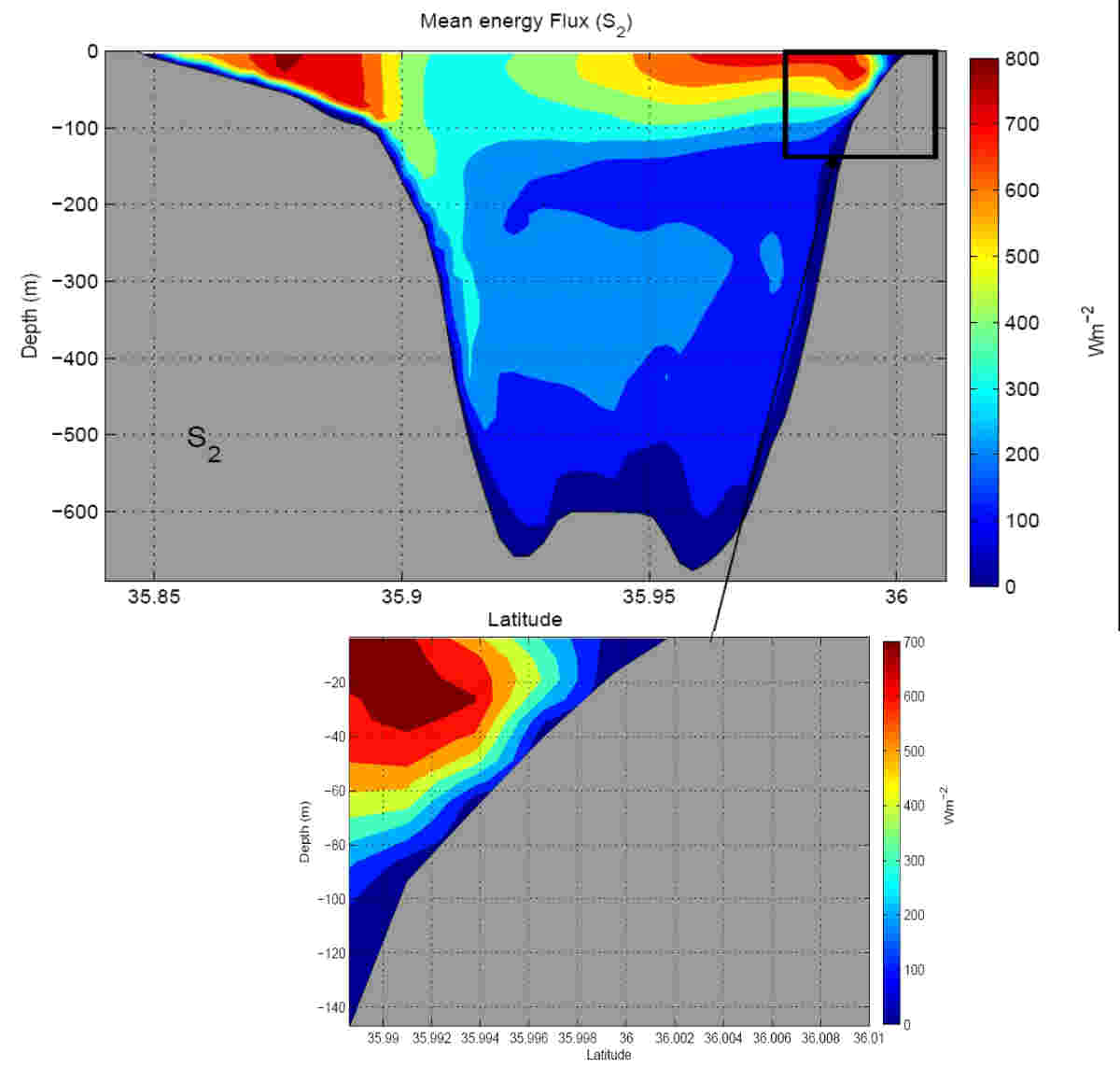 Mean energy flux at Section S2 shows two areas of large potential for power generation near Morocan (located on the left) and Spanish (on the right) coasts, the energy flux diminishing markedly in the middle of the channel. Lower panel is a zoom of the area nearby Spain indicated by the rectangle in the upper panel. It shows a noticeable core of high values at intermediate depths (between 20 and 60 m) with peak values around 700 W/m2.
Mean energy flux at Section S2 shows two areas of large potential for power generation near Morocan (located on the left) and Spanish (on the right) coasts, the energy flux diminishing markedly in the middle of the channel. Lower panel is a zoom of the area nearby Spain indicated by the rectangle in the upper panel. It shows a noticeable core of high values at intermediate depths (between 20 and 60 m) with peak values around 700 W/m2.
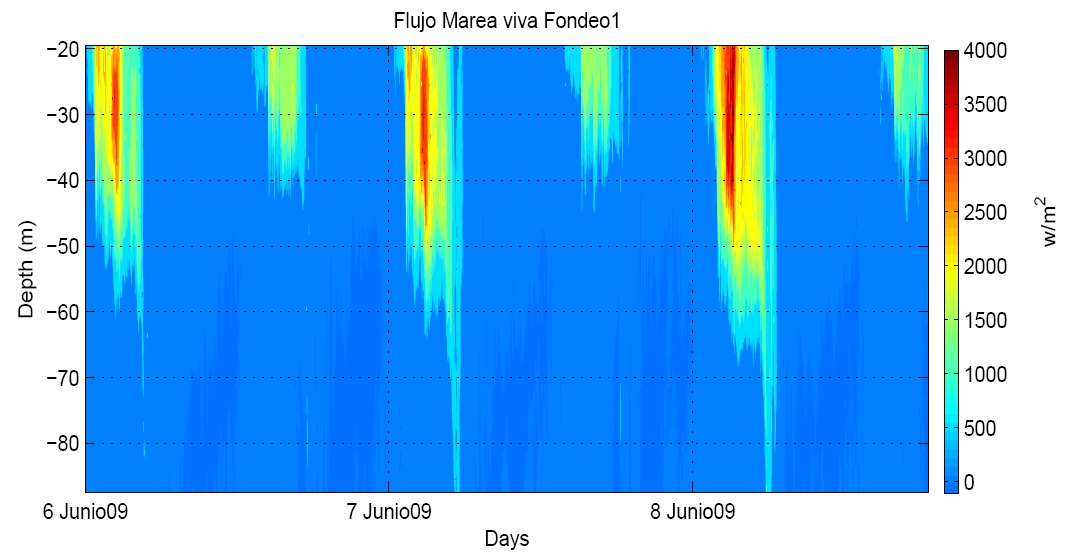
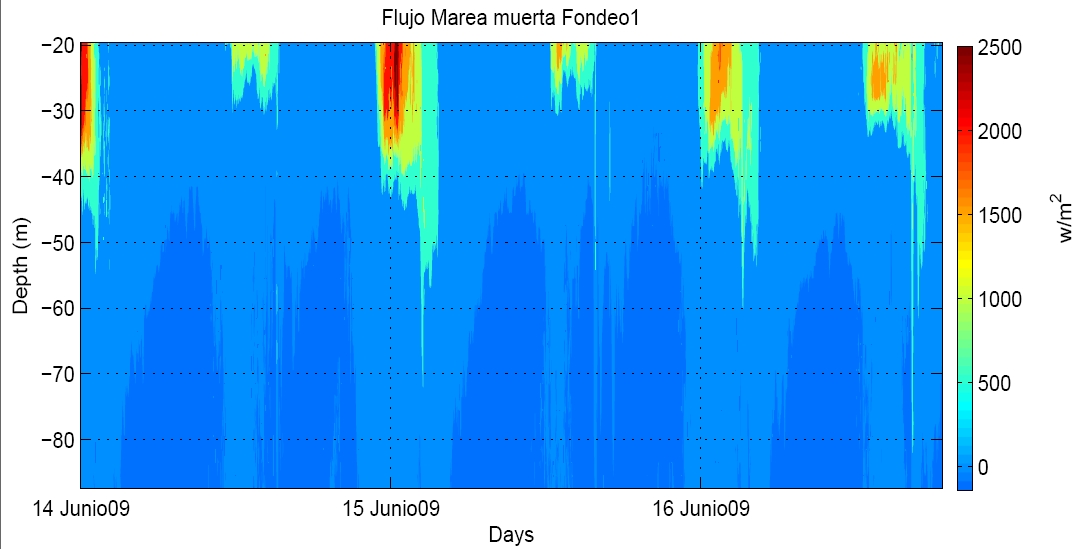 Left panel is the instantaneous energy flux at the position of station 1 (westernmost of the four sampled sites indicated in the map showed above during three days spanning a period of spring tides. Peak values close to 4000 W/m2 are observed. Right panels show the same information at the same time during a period of neap tides, when peak values diminish by 40% approximately. More information can be found in the files below (in Spanish).
Left panel is the instantaneous energy flux at the position of station 1 (westernmost of the four sampled sites indicated in the map showed above during three days spanning a period of spring tides. Peak values close to 4000 W/m2 are observed. Right panels show the same information at the same time during a period of neap tides, when peak values diminish by 40% approximately. More information can be found in the files below (in Spanish).
